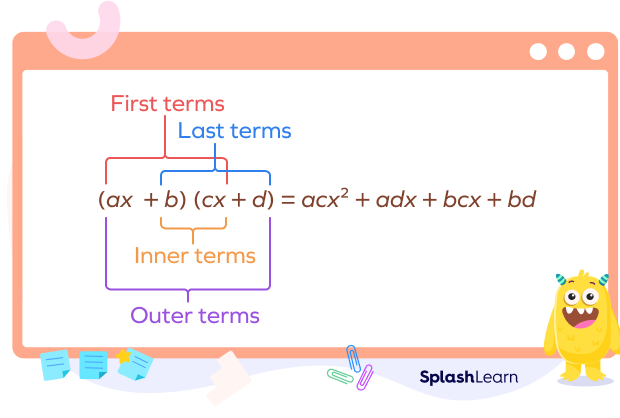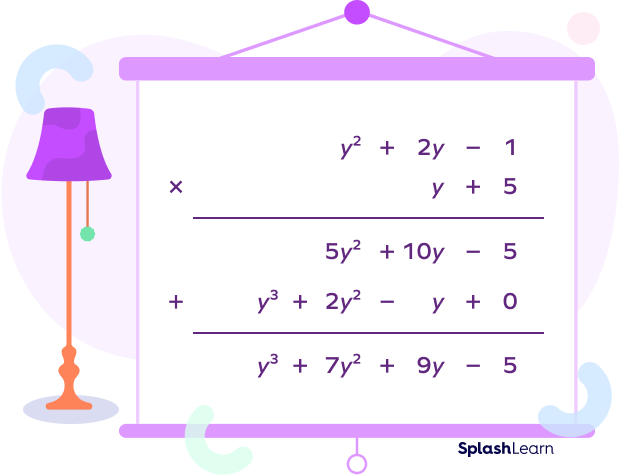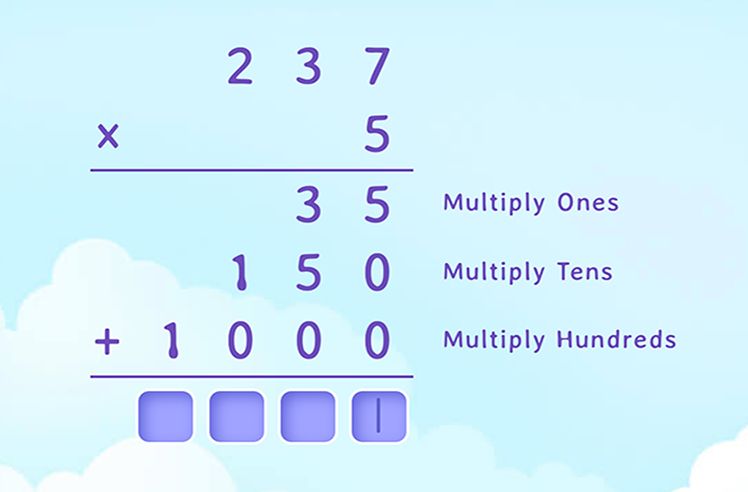What Is the Multiplication of Polynomials?
To multiply two polynomials, we use the distributive property of multiplication where we multiply each term of the first polynomial by each term of the second polynomial. While doing so, we multiply variables with variables, coefficients with coefficients, and finally add all the results together.
There are different types of polynomials based on the number of terms, such as monomials, binomials, trinomials, and so on. We use different strategies to multiply different types of polynomials together.
Recommended Games
Rules for Multiplying Polynomials
In the multiplication of polynomials, the polynomials can be monomials, binomials, trinomials, etc. The steps to multiply two or more polynomials are as follows:
Step 1: If any one of the polynomials contains more than one term, then first apply the distributive law of multiplication to multiply each term in one polynomial by each term in the other polynomial.
Step 2: Using the laws of exponents, add the powers of the same variables.
Step 3: Add or subtract the like terms and then simplify to get the final results.
Recommended Worksheets
Multiplying Polynomials using Exponents Law
When we multiply two terms in which the same variables are present, we use the laws of exponents.
am × an = am + n
Note that we multiply the coefficients of the variables separately.
Example: $11 x^{2} \times 2x^{5} = 22x^{7}$
Multiplying Polynomials with Different or Mixed Variables
It is not necessary that the polynomials being multiplied should be in the same variable. If the two polynomials have different or mixed variables, we use the following rules.
- Multiply all the coefficients.
- Apply the exponent rules when multiplying the same variables.
- Other variables are simply multiplied together in the answer.
Example:
$4x^{2}\;y \times 3yz = 12x^{2}\;y^{2}\;z$
$2x \times (\;-\; 5)xy \times 7z = \;-\; 70x^{2}\;yz$
How To Multiply Polynomials
To learn how to multiply polynomials, we will discuss different categories, such as
- Multiplying monomials
- Multiplying binomials
- Multiplying a monomial and a binomial
- Multiplying a binomial and a trinomial
This way it will be easier to understand how to approach different types of problems involving multiplying polynomials. Let’s discuss these cases in detail.
Multiplication of Monomials
Monomial is a polynomial containing only one term. This term can be a constant, a variable with a coefficient or a product of one or more variables with a coefficient.
Multiplication of Two Monomials
Here, we just have to multiply the single term of the first monomial by the single term of the other monomial. Multiply variables with variables, coefficients with coefficients, and combine the result. If both the monomials have the same variable then their exponents are added together.
Examples:
$4x \times 5x = (4 \times 5) \times (x \times x) = 20x^{1+1} = 20x^{2}$
$8xy \times 7xy^{2} = (8 \times 7) \times (x \times x) \times (y \times y^{2}) = 56\; x^{2}\;y^{3}$
Multiplication of Three Monomials
Here, we multiply three terms together. We can multiply three monomials by applying the same method as multiplying two monomials.
Examples:
$4x \times 5x \times 6x = (4 \times 5 \times 6) \times (x \times x \times x) = 120x^{1+1+1} = 120x^{3}$
$x \times 6xy \times xyz = (1 \times 6)(x \times x \times x) \times z = 6x^{3}\;y^{2}\;z$
Multiplication of Binomials
A binomial is a polynomial with only two terms. To multiply binomials, we use the distributive property of multiplication. We first multiply the first term of the first binomial by each term of the second binomial. Next, we multiply the second term of the first binomial by each term of the second binomial. Finally, we combine all the results using the operators.
The mnemonic FOIL can be used to remember and understand the pattern used in the multiplying binomials.
F: First terms
O: Outer terms
I: Inner terms
L: Last terms

Multiplying Binomials Using Distributive Property
Multiplication of a binomial $(a + b)$ with a binomial $(c + d)$ can be given as
$(a + b) \times (c + d) = a \times (c + d) + b \times (c + d)$
$= ac + ad + bc + bd$
Example:
$(x \;-\; 2y ) \times (x^{3} + yz) = x(x^{3} + yz) \;-\; 2y(x^{3} + yz)$
$ = x^{4} + xyz \;-\; 2x^{3}\;y\;-\;2y^{2}\;z$
Multiplying Binomials Using the Box Method
We can multiply two binomials using the box method. Write the individual terms of two binomials along the rows and columns of a 22 box. Every cell contains the product of the terms it represents along the row and the column. Add all the products together to get the final result.
Example: (x–2)(y+xz)
| x | $\;-\;2$ | |
| y | xy | $\;-\;2y$ |
| xz | x2z | $\;-\;2xz$ |
$(x \;-\; 2)(y + xz) = x^{2}\;z + xy \;-\; 2xz \;-\; 2y$
How to Multiply a Monomial with a Binomial
To multiply a monomial with a binomial use the distributive property of multiplication.
Multiplication of a monomial a with a binomial $(b + c)$ can be given as
$a(b + c) = (a \times b) + (a \times c)$
Example:
$2x \times (x + y) = 2x \times x + 2x \times y = 2x^{2} + 2xy$
How to Multiply Binomial with a Trinomial
A binomial (m + n) can be multiplied with a trinomial $(a + b + c)$ as
$(m + n) \times (a + b + c) = \left[m (a + b + c)\right] + \left[n (a + b + c)\right]$
$= am + bm + cm + an + bn + cn$
Example:
$2xy \times (x + 5y + z) = 2x^{2}\;y + 2xyz$
Polynomial Long Multiplication
The horizontal multiplication method is convenient to use when we are dealing with small polynomials. However, if we wish to multiply polynomials having three or more terms, we can prefer the long multiplication method. It is exactly the same as the method of long multiplication for numbers.
Let’s understand with an example.
Example: $(y^{2} + 2y \;-\; 1) \times (y + 5)$

Facts about Multiplying Polynomials
- Multiplication of polynomials follows commutative property as well as associative property.
- The degree of the product of two or more polynomials with one variable is less than or equal to the sum of the degrees of each polynomial.
- A variable without exponent in a polynomial is said to have exponent 1. $x = x^{1}$
- If you multiply a polynomial with a non-zero constant, the degree of the polynomial will not be affected.
- Multiplying polynomials requires careful attention to the signs of the terms.
Conclusion
In this article, we have discussed the multiplication of polynomials with the help of different cases. Let’s solve a few examples and practice problems to recall and revise these concepts.
Solved Examples on Multiplying Polynomials
1. Find the product of $4x$ and $9x$.
Solution:
We have to multiply two monomials $4x$ and $9x$.
Required product $=4x \times 9x$
$=(4 \times 9)x^{1+1}$
$=36x^{2}$
2. Find the product of $p$, $3p$, and $5p + q$.
Solution:
$p \times 3p \times (5p + q) = 3 \times 5 \times p \times p \times (5p + q)$
$=15p^{2} \times (5p + q)$
$= (15p^{2} \times 5p) + (15p^{2} + q)$
$= 75p^{3} + 15p^{2} \;q$
3. Multiply the two binomials: $(x^{2} + 7x)(x + 1)$.
Verify the answer using the box method.
Solution:
$(x^{2} + 7x)(x + 1) = x^{2}(x + 1) + 7x (x + 1)$
$= x^{3} + x^{2} + 7x^{2} + 7x$
$= x^{3} + 8×2 + 7x$
Box method:
| $x^{2}$ | 7x | |
| x | $x^{3}$ | $7x^{2}$ |
| 1 | $x^{2}$ | 7x |
$\bigg(x^{2} + 7x \bigg)(x +1) = x^{3} + x^{2} + 7x^{2} + 7x = x^{3} + 8x^{2}$
4. Find the product of y and $(3y + 2)$.
Solution:
Let’s multiply the monomial y and binomial $(3y + 2)$.
Required product $= y(3y + 2) = (3y \times y) + 2y = 3y^{2} + 2y$
5. Find the product of $(x + 1)$ and $(x + 4)$.
Solution:
Required product $= (x + 1)(x + 4)$
$=x (x + 4) + 1(x + 4)$
$=x \times x + 4x + x + 4$
$= x^{2} + 5x + 4$
6. Multiply $(2x^{2} + 5)(x^{2} \;-\; 3x + 2)$ using long multiplication.
Solution:

Practice Problems on Multiplying Polynomials
Multiplying Polynomials: Definition, Steps, Methods, Examples, Facts
What is the product of $4t^{2}$ and $7^{t}$?
Required product $=4t^{2} \times 7t = 4 \times 7 \times t^{2} \times t = 28t^{3}$
What is the product of x and $(x \;–\; 3)$?
Required product $= x(x \;–\; 3) = x^{2} \;-\; 3x$
What is the coefficient of the product of $5x^{2},\; 4y$, and $2y$?
$5x^{2} \times 4y \times 2y = (5 \times 4 \times 2)(x^{2} \times y \times y) = 40x^{2}\;y^{2}$
Hence, the coefficient of the product of $5x^{2},\; 4y$ and 2y is 40.
What is the product of $(2x \;–\; 1)(3x + 4)$?
$(2x \;–\; 1)(3x + 4)$
$= 6x^{2} + 8x \;–\; 3x \;–\; 4$
$= 6x^{2} + 5x \;–\; 4$
The product of $(l + 3m)$ and $(l\;-\;2m)$ is equal to:
Required product $= (l + 3m) (l \;-\; 2m)$
$= l^{2} \;-\; 2ml + 3ml \;-\; 6m^{2}$
$= l^{2} + ml \;-\; 6m^{2}$
Frequently Asked Questions on Multiplying Polynomials
What is binomial?
A polynomial that has only two terms is called a binomial.
What is trinomial?
A polynomial that has only three terms is called a trinomial.
How do you multiply polynomials with mixed variables?
Multiply all the coefficients. Multiply the same variables using the laws of exponents. Multiply these two products with the remaining variables to get the answer.Example: $5x \times 2xy \times 5xyz = 50x^{3}\;y^{2}\;z$
What is the product of two or more monomials?
The product of two or more monomials is also a monomial.
What is the degree of the product polynomial when multiplying two polynomials of the same degree?
When multiplying two polynomials of the same degree, the degree of the product polynomial is twice the degree of the two polynomials being multiplied.




































